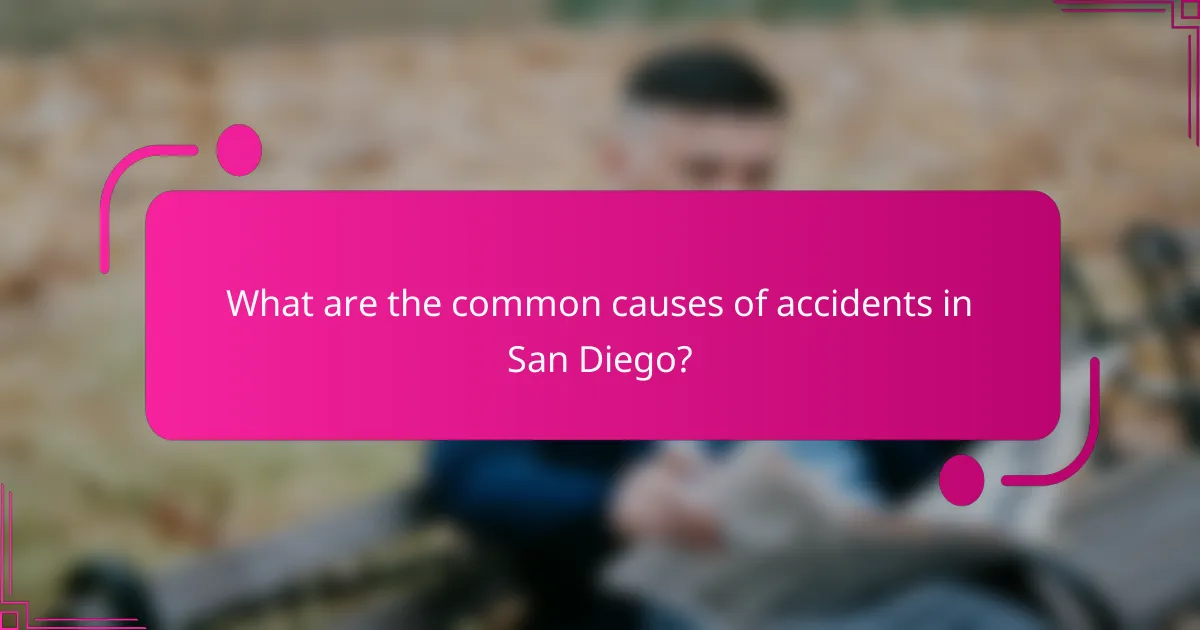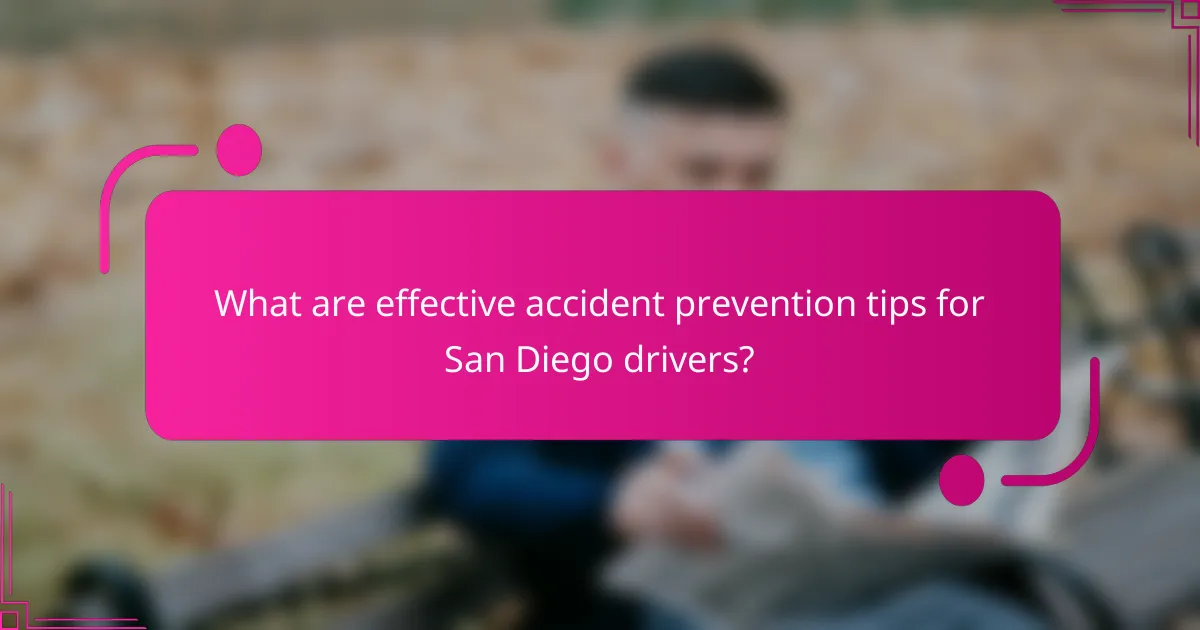
What is San Diego Traffic Safety?
San Diego Traffic Safety refers to the measures and practices aimed at reducing traffic accidents and ensuring the safety of road users in San Diego. It encompasses various initiatives, including public awareness campaigns and law enforcement efforts. The objective is to minimize fatalities and injuries on the road. In 2021, San Diego reported over 12,000 traffic collisions, highlighting the importance of effective traffic safety measures. Local authorities implement strategies such as improving road infrastructure and enforcing traffic laws. Community programs also educate residents about safe driving practices. Overall, San Diego Traffic Safety is vital for protecting the lives of drivers, pedestrians, and cyclists.
How do road conditions impact traffic safety in San Diego?
Road conditions significantly impact traffic safety in San Diego. Poorly maintained roads can lead to accidents. Potholes, cracks, and uneven surfaces increase the risk of vehicle damage and loss of control. Rainy weather can exacerbate these issues, leading to slippery conditions. According to the California Office of Traffic Safety, wet roads contribute to a higher percentage of accidents. Additionally, visibility issues from road debris or inadequate lighting can further compromise safety. Proper road maintenance is crucial for reducing these risks and improving overall traffic safety.
What are the main types of road conditions affecting safety?
The main types of road conditions affecting safety include wet roads, icy surfaces, potholes, and construction zones. Wet roads can reduce tire traction, increasing the likelihood of skidding. Icy surfaces significantly impair vehicle control, leading to accidents. Potholes can cause sudden vehicle damage and loss of control. Construction zones often have uneven surfaces and require reduced speed, creating hazards. According to the Federal Highway Administration, poor road conditions contribute to a significant percentage of traffic accidents annually.
How do weather conditions influence road safety?
Weather conditions significantly influence road safety. Rain, snow, fog, and ice can reduce visibility and traction. For instance, wet roads increase stopping distances by up to 50%. Fog can limit visibility to less than 100 feet, making it difficult for drivers to react. Snow and ice can lead to loss of control, causing skidding and accidents. According to the Federal Highway Administration, adverse weather contributes to approximately 21% of all vehicle crashes. Drivers must adjust their speed and increase following distances in poor weather. Awareness of changing conditions is crucial for preventing accidents.
Why is traffic safety important for San Diego residents?
Traffic safety is crucial for San Diego residents to reduce accidents and fatalities. San Diego has high traffic volume, increasing the likelihood of collisions. In 2021, the city reported over 3,000 traffic accidents, resulting in numerous injuries and deaths. Safe driving practices can significantly lower these statistics. Effective traffic safety measures protect pedestrians, cyclists, and drivers alike. Enhanced road infrastructure, such as well-marked crosswalks and traffic signals, contributes to safer conditions. Public awareness campaigns also play a vital role in educating residents about safe driving behaviors. Overall, prioritizing traffic safety fosters a healthier, more secure community.
What statistics highlight the need for improved traffic safety?
In 2020, there were over 38,000 fatalities from motor vehicle crashes in the U.S. This marked a significant increase compared to previous years. In San Diego, traffic collisions resulted in over 20,000 injuries annually. Pedestrian fatalities in the city rose by 25% from 2019 to 2020. Distracted driving contributes to approximately 9% of all fatal crashes. The National Highway Traffic Safety Administration reports that speeding is a factor in nearly one-third of all traffic fatalities. Additionally, the economic cost of traffic accidents exceeds $800 billion each year in the U.S. These statistics underscore the urgent need for improved traffic safety measures.
How does traffic safety affect community well-being?
Traffic safety significantly impacts community well-being by reducing accidents and fatalities. Safe road conditions lead to fewer injuries and deaths, which enhances the overall quality of life. A community with lower traffic incidents experiences less trauma and emotional distress among residents. Improved traffic safety can also promote economic stability by reducing healthcare costs associated with accidents. According to the National Highway Traffic Safety Administration, effective traffic safety measures can decrease fatal crashes by up to 30%. Furthermore, communities with better traffic safety often enjoy increased social cohesion as residents feel safer and more connected. Overall, prioritizing traffic safety fosters a healthier, more vibrant community.

What are the common causes of accidents in San Diego?
Common causes of accidents in San Diego include distracted driving, speeding, and driving under the influence. Distracted driving accounts for a significant percentage of collisions. It often involves texting or using mobile devices while driving. Speeding increases the severity of accidents and reduces reaction time. Driving under the influence of alcohol or drugs impairs judgment and coordination. Additionally, poor weather conditions, such as rain or fog, contribute to accidents. Intersections and high-traffic areas are common locations for collisions. According to the California Office of Traffic Safety, San Diego County has a high rate of traffic-related injuries and fatalities.
How do driver behaviors contribute to accidents?
Driver behaviors significantly contribute to accidents through actions such as distracted driving, speeding, and aggressive maneuvers. Distracted driving, which includes texting or using a phone, is a leading cause of collisions. According to the National Highway Traffic Safety Administration, 3,142 fatalities occurred in 2019 due to distracted driving. Speeding reduces a driver’s ability to react to obstacles, increasing the severity of accidents. Research indicates that speeding contributes to 29% of all traffic fatalities. Aggressive driving behaviors, like tailgating and road rage, often lead to dangerous situations that escalate quickly. In fact, the AAA Foundation for Traffic Safety reports that aggressive driving accounts for nearly 56% of fatal crashes. Overall, these behaviors create hazardous conditions that elevate the risk of accidents on the road.
What role does distracted driving play in accidents?
Distracted driving significantly increases the likelihood of accidents. It diverts attention from the road, impairing a driver’s ability to react promptly. According to the National Highway Traffic Safety Administration, distracted driving was responsible for 3,142 fatalities in 2019. Common distractions include texting, talking on the phone, and adjusting in-car technology. These distractions can lead to slower reaction times and reduced awareness of surroundings. Research indicates that texting while driving increases crash risk by 23 times. Thus, distracted driving plays a critical role in road safety issues.
How does speeding affect the likelihood of accidents?
Speeding significantly increases the likelihood of accidents. When drivers exceed speed limits, they have less time to react to obstacles. High speeds reduce a driver’s ability to steer safely around curves or objects. According to the National Highway Traffic Safety Administration, speeding contributes to nearly one-third of all motor vehicle fatalities. The faster a vehicle travels, the greater the stopping distance required. This means that at higher speeds, the chances of a crash occurring escalate. Additionally, speeding can lead to more severe accidents due to the increased force of impact.
What environmental factors contribute to traffic accidents?
Environmental factors that contribute to traffic accidents include poor weather conditions, road surface quality, and visibility issues. Adverse weather, such as rain, snow, or fog, can significantly reduce traction and visibility. According to the Federal Highway Administration, wet roads are a factor in nearly 75% of weather-related crashes. Road surface quality, including potholes and debris, can lead to loss of vehicle control. Poorly maintained roads increase the risk of accidents. Visibility issues, such as inadequate street lighting or obstructed road signs, can hinder a driver’s ability to react promptly. Studies show that nighttime accidents are more likely due to reduced visibility. Therefore, these environmental factors play a crucial role in traffic safety.
How do road design and infrastructure impact accident rates?
Road design and infrastructure significantly impact accident rates. Well-designed roads can enhance safety by reducing hazards. Features like proper signage, lane markings, and adequate lighting improve driver awareness. Conversely, poorly designed roads can lead to confusion and increased risk of collisions. For instance, roads with sharp turns or inadequate shoulders can contribute to higher accident rates. A study by the Federal Highway Administration found that road design improvements reduced crash rates by up to 30%. Additionally, urban areas with better infrastructure, such as bike lanes and pedestrian crossings, show lower accident rates. These statistics demonstrate the critical role of effective road design in promoting traffic safety.
What are the effects of poor visibility on traffic safety?
Poor visibility significantly reduces traffic safety. It increases the likelihood of accidents due to limited sight distance. Drivers may not see obstacles, pedestrians, or other vehicles in time to react. Studies show that reduced visibility contributes to a higher rate of collisions. For instance, fog, rain, or nighttime conditions can obscure road signs and traffic signals. According to the National Highway Traffic Safety Administration, nearly 50% of fatal crashes occur in low visibility conditions. This data highlights the critical impact of visibility on safe driving practices.

What are effective accident prevention tips for San Diego drivers?
Effective accident prevention tips for San Diego drivers include adhering to speed limits and avoiding distractions. San Diego’s roads can be busy, making it crucial to stay focused. Drivers should use hands-free devices for calls to minimize distractions. Additionally, maintaining a safe following distance helps in reacting to sudden stops. Utilizing turn signals when changing lanes or turning is essential for communication with other drivers. Weather conditions like rain can create hazardous driving situations, so adjusting speed accordingly is vital. Regular vehicle maintenance, including checking brakes and tires, enhances safety. Lastly, being aware of pedestrian zones and cyclists is important, as San Diego has many active areas.
How can drivers improve their awareness on the road?
Drivers can improve their awareness on the road by practicing defensive driving techniques. This includes maintaining a safe following distance from the vehicle ahead. It is essential to minimize distractions, such as mobile devices and loud music. Regularly scanning the environment helps in detecting potential hazards early. Using mirrors frequently allows drivers to be aware of vehicles in adjacent lanes. Staying informed about road conditions and traffic updates enhances situational awareness. Participating in driving courses can also sharpen skills and increase awareness. Studies show that defensive driving reduces accidents by 30%, underscoring its effectiveness.
What techniques can help reduce distractions while driving?
To reduce distractions while driving, drivers should implement several techniques. First, they can silence their mobile devices to avoid notifications. This action minimizes the temptation to check messages or calls. Second, they should set up navigation before starting their trip. Pre-planning routes helps avoid fumbling with devices while driving. Third, using hands-free devices for calls can keep hands on the wheel. Research shows that hands-free systems are safer than handheld devices. Fourth, drivers should keep the vehicle environment organized. A clutter-free space reduces the likelihood of distractions. Lastly, they can practice mindfulness while driving. Staying focused on the road enhances attention and reduces the chance of accidents.
How important is it to follow traffic signals and signs?
Following traffic signals and signs is crucial for road safety. They regulate vehicle and pedestrian movements, reducing the risk of accidents. According to the National Highway Traffic Safety Administration, obeying traffic signals prevents approximately 1.2 million crashes annually in the U.S. These signals guide drivers in making safe decisions at intersections and busy roads. Ignoring them can lead to collisions, injuries, and fatalities. In San Diego, adherence to these regulations is vital due to high traffic volumes and diverse road conditions. Overall, following traffic signals and signs significantly enhances safety for all road users.
What safety measures can be taken to enhance road conditions?
Implementing safety measures can significantly enhance road conditions. Regular maintenance of road surfaces prevents deterioration. Proper drainage systems reduce flooding and water accumulation. Installing clear signage improves driver awareness and navigation. Adequate lighting enhances visibility during night driving. Traffic calming measures, such as speed bumps, can reduce vehicle speeds. Regular inspections identify hazards like potholes and cracks. Public awareness campaigns educate drivers on safe driving practices. These measures collectively contribute to safer road environments.
How can regular vehicle maintenance contribute to safety?
Regular vehicle maintenance enhances safety by ensuring that all critical systems function properly. This includes brakes, tires, lights, and steering components. Properly maintained brakes reduce stopping distances and improve vehicle control. Well-inflated tires increase traction and decrease the risk of blowouts. Functioning lights ensure visibility to other drivers, especially at night. Regular checks of fluid levels prevent engine overheating and potential failures. A study by the National Highway Traffic Safety Administration shows that routine maintenance can reduce accident risks significantly. In fact, vehicles that are regularly serviced have a lower incidence of mechanical failures that lead to crashes.
What role does community involvement play in promoting traffic safety?
Community involvement plays a crucial role in promoting traffic safety. Engaged communities can effectively identify local traffic issues. They can organize awareness campaigns to educate residents about safe driving practices. Community members can participate in neighborhood watch programs focused on reporting reckless driving. Collaborative efforts with local law enforcement enhance enforcement of traffic regulations. Studies show that areas with active community programs experience reduced accident rates. For instance, a report by the National Highway Traffic Safety Administration highlights that community-led initiatives can lower crash incidents by up to 30%. This underscores the importance of community engagement in fostering safer road environments.
What resources are available for San Diego drivers to stay informed about traffic safety?
San Diego drivers can access various resources to stay informed about traffic safety. The California Department of Transportation (Caltrans) provides real-time traffic updates through its website and mobile app. Local news outlets also report on traffic conditions and safety alerts. The San Diego Police Department shares information on road safety initiatives via their official website and social media channels. Additionally, the 511 San Diego service offers traffic information through phone calls and online platforms. Community organizations often host workshops on safe driving practices. These resources collectively help drivers stay updated on traffic safety in San Diego.
How can local government initiatives improve traffic conditions?
Local government initiatives can improve traffic conditions through various strategies. Implementing better traffic signal management can reduce congestion. For instance, adaptive traffic signals can adjust timing based on real-time traffic flow. Expanding public transportation options encourages fewer vehicles on the road. Studies show that cities with robust public transit systems experience reduced traffic volume.
Developing dedicated bike lanes promotes cycling as a viable transport option. Research indicates that cities with extensive bike infrastructure see decreased car usage. Conducting regular road maintenance prevents accidents caused by poor road conditions. Data from the Federal Highway Administration highlights that well-maintained roads significantly reduce crash rates.
Community engagement initiatives can raise awareness about safe driving practices. Programs that educate drivers about traffic laws can lead to better compliance. Implementing stricter enforcement of traffic laws can deter reckless driving behavior. Statistics from the National Highway Traffic Safety Administration demonstrate that increased enforcement correlates with lower accident rates.
Overall, local government initiatives play a crucial role in improving traffic conditions through infrastructure, public transport, education, and enforcement.
What online tools can help drivers monitor road conditions and safety tips?
Online tools that help drivers monitor road conditions and safety tips include apps and websites like Waze, Google Maps, and INRIX. Waze provides real-time traffic updates and alerts about road hazards. Google Maps offers live traffic conditions and estimated travel times. INRIX delivers traffic data and predictive analytics for better route planning. These tools aggregate user-generated data and official sources to enhance driving safety. They can inform users about accidents, road closures, and weather conditions. Utilizing these resources can significantly improve awareness and decision-making for drivers on the road.
San Diego Traffic Safety encompasses measures aimed at reducing traffic accidents and ensuring the safety of road users through public awareness campaigns, law enforcement, and improved road infrastructure. The article highlights the impact of road and weather conditions on safety, identifies common causes of accidents, and emphasizes the importance of effective driver behaviors. It also discusses community involvement, local government initiatives, and available resources to enhance traffic safety in San Diego. Key statistics underscore the urgent need for improved safety measures to protect drivers, pedestrians, and cyclists in the region.